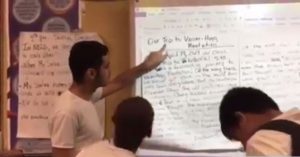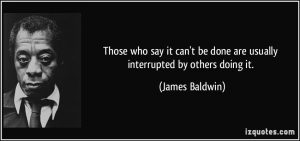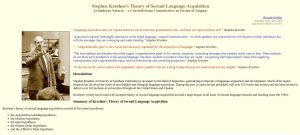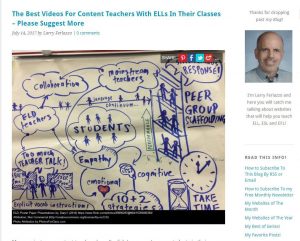How fast can you acquire a second language? Pretty darn fast if we offer comprehensible input, in a low stress environment, and you are a motivated learner. If this all happens in an engaging thematic unit that is directly related to grade-level standards… BOOM! You are both acquiring the language and learning content at grade-level. Why would this be any different for SIFE (a student with interrupted or limited formal education)? Every child has unique needs, but this post is about methods to help SIFE aquire English. Read on and I’ll try to explain my understanding. I hope these ideas are good enough for you to challenge them!
So I believe that when my students acquire language quickly, they are acquiring mostly BICS (Basic Language) and the solid research by Jim Cummins stating that it takes 5-7 years to acquire enough language for the ELL (English Language Learner) to be working on level with native peers. I am not disputing this research. I am saying that you can go faster than the norm with your basic language. And your teacher can accommodate instruction to allow you to work at grade level the day you arrive in your new country. All of this can help the learner in the area of motivation which is a key factor in how quickly a person learns anything.
I want to know all the research I can but I like to go deeper in theories that are research-based and also give us clear strategies for helping students succeed (vs. the research that tells us how poorly ELLs are performing on standardized test, etc..Ugh!) I also love real stories of people who are beating the odds because they are supported well or they are taking full advantage of opportunities, growth mindset, innovative ways of learning. I like to see just exactly WHAT is possible!
I had a researcher tell me that one of my videos of a student accelerating his second language acquisition was an anomaly. That researcher visited my class and met many anomalies. So he said, “Actually…. it’s the teacher. The teacher is the anomaly.” Ha! That’s fine. I am happy to be that. Any one of us can be an anomaly (something different than the norm). Believing that are kids can do more than people might think…showing it…that is exactly how a new normal begins to take hold.
Theory
What does it take for your class to all feel like they can beat the odds? A combination of things for sure. A key answer for me is this: Use research-based practices and keep challenging your own mindset and the mindset of your students. Keep an asset-mentality even in September & October! At the start of the school year when we all get amnesia. When we feel like the process is going sooo slowly. Find your like-minded PLN and remind yourselves of your WHY. And what you know to be true. Every kid CAN. Every kid.
Consciously push out any negative, deficit-mentality thoughts you might have about SIFE, Non-English speakers or children from poverty. It’s important for me to understand where statistics come from. But as we discussed last week, we can get a lot further focusing on the research and statistics that show advantages and possibilities for our students. When we do this, they know we are serious about believing in them and that begins to help them to believe in themselves.
This week I want to of fer more resources that deepened my understanding of language acquisition vs. language learning. I am using terms that come from my study of Stephen Krashen’s work. Krashen offers to us that Comprehensible Input is one of the most important factors in how you acquire your 2nd language. As a teacher, I must make my messages comprehensible/understandable to the language learner. I can do this with a variety of sheltered strategies. Some examples of those strategies, are things that work well for ALL students. But these are critical for our language learners: visuals, gestures, slowing my rate of speech are just a few. Below I will offer links to videos that have examples.
fer more resources that deepened my understanding of language acquisition vs. language learning. I am using terms that come from my study of Stephen Krashen’s work. Krashen offers to us that Comprehensible Input is one of the most important factors in how you acquire your 2nd language. As a teacher, I must make my messages comprehensible/understandable to the language learner. I can do this with a variety of sheltered strategies. Some examples of those strategies, are things that work well for ALL students. But these are critical for our language learners: visuals, gestures, slowing my rate of speech are just a few. Below I will offer links to videos that have examples.
For a great overview of Stephen Krashen’s theories (they are so important for us to understand), read through this short document from his website. It is his Theory of Second Language Acquisition with research cited there as well:
I love all the theory. It gives such hope for every learner if we can leverage things like lowering the affective filter and amping up some simple things like gestures and visuals for comprehensible input. It’s more complicated for sure, but what a practical place to start!
How About Short Classes on ESL? Or a Conference!
So what does some of this look like? Hmmmm……Wouldn’t it be great if you could go to an awesome ESL conference with big name keynote speakers who are proven experts in the field? And there were a variety of 30-45 min ESL breakout sessions so you could pick the ones that made sense for your reality? And, Oh! Wouldn’t it be wonderful if you could do that in your slippers & house robe, on demand, whenever you wanted?
You guessed it. You totally can.
https://sites.google.com/view/virtuel/home
Thanks to the brainchild of Tan Huynh, the first annual #VirtuEL streamed live in June 2017. But that was just the first year and that was only the live date. The conference is available to anyone, at any time. No, we don’t need your email, you won’t get spam from us. This is all free and on YouTube. Just check out the first 5 minutes of Nancy Motely‘s Keynote session from that first year and you will be hooked.
The feedback is very positive. If you follow these presenters, you can get so much free PD, you won’t know what to do with it all! These professionals were hand-picked for their track record of sharing free, high-quality ESL training content.
Best of Lists from Larry Ferlazzo
One other website I would check out this week is Larry Ferlazzo’s blog. He spends so much time collecting the best of everything for us! For content teachers, this post is great place to start: “Best Short Videos for Content Teachers with ELLs.”
Gotta run but please reach out with questions. There is so much more to learn from all of us. That is why we are chatting it up over on Twitter & Facebook. Please come challenge my ideas so we can think even more deeply about our learners.
Week 4 Book Study Questions!
For more on the book study, please visit my Boosting Achievement Book Study landing page. It has links to the previous weeks and lots more good stuff.
WEEK FOUR QUESTIONS (Answer some of these, all of these or none of these. We welcome all ideas, reflections & insight!)
4Q1) p. 48 – 49 Watch the video with the QR Code or here: bit.ly/ThematicUnit4ESL. Emmanuel was preliterate in any language but had a strong desire to communicate with the visitor. What language standards for emergent readers were met in preparation for Dr. Babaloa? What else stands out about the video or the story on p. 48?
4Q2) p. 50 What is the difference between learning a language and acquiring a language? Why is the distinction especially important for SIFE?
4Q3) p. 51 & 52 Read US History Experience with Paul Spellman on page 52 that describes how Carol’s Newcomer class prepared for an author visit. This video was made for Dr. Spellman: bit.ly/AuthorVisitPrep Many of the students were compelled to read Dr. Spellman’s book. Why? What else did you notice?
4Q4) p. 58 -59 The content teacher and the ESL teacher use language in different ways. What are your take-aways from this?
4Q5) p. 60 – 61 How is the focus different for the sheltered science teacher vs the ESL teacher who decides to use science in a unit? What stands out to you on these pages?
4Q6) p. 62 Carol explains that English Learners should be assessed according to their level of English language proficiency. We must understand the proficiency descriptors to meet students where they are for language when assessing. But what if that student has not been offered comprehensible input? What can schools do to help content teachers offer comprehensible input to ELs?
4Q7) p. 63 The reality for some learners who are SIFE is that they may not master courses like Algebra I if they do not have the foundational skills necessary for the class. What hope is there for this student? Read page 63 and respond with what the author suggests or other ideas you have for supporting these students.



